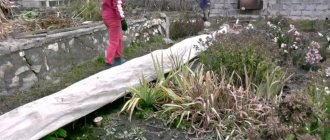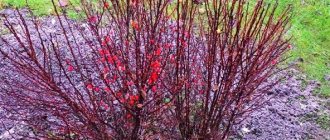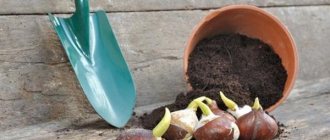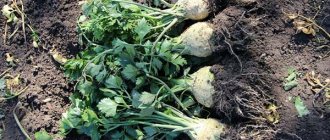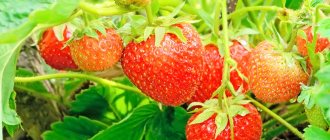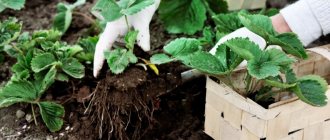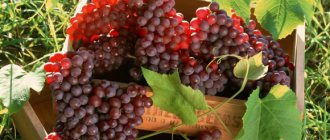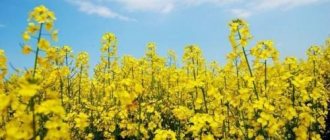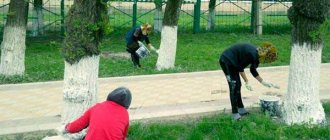Features of apple tree shelter
From the Urals to Siberia, covering work should begin from the end of November. In winter, immediately after heavy snowfall, the tree trunk is covered with snow. In this case, the snow layer should be at least a meter. The protection will remain in effect until spring.
In Siberia, preparation for the cold season involves covering apple trees with spruce branches or fabric. The trunk must be covered for at least one and a half meters, and the covering material on top is fixed with a rope. So, regardless of the variety, the tree will be protected from sunburn, frost and rodents.
In the conditions of the Urals, covering the roots is also of great importance. In this case, manure and sawdust are used. Then a mound of earth is made around the seedling, the height of which should be 30 centimeters.
For each variety of columnar apple tree, insulation of the apical bud is also necessary for winter. Insulation is carried out using film or rags. Then the seedling is tied to a support.
Frostbites on apple trees
This is a phenomenon triggered by a very cold winter or a prolonged thaw. This depression that appears on the trunk or at the base of the branches is called a frost hole. Frost holes appear when there are sudden changes in ambient temperature.
This phenomenon is associated with a more rapid compression of the outer parts of the trunk. The fluid released from the cells freezes and causes the wood to become stressed and rupture.
The tree changes color from white to light brown or even brown, losing its ability to feed. There is a blockage of blood vessels inside the apple tree. Nutrition does not reach the young shoots, but is mixed with clogging substances or can even flow out of the frost holes of the trunk.
Pests settle around the frost hole under the separated bark and diseases develop.
IMPORTANT! Undetected frost damage in time leads to the appearance of a hollow trunk and a decrease in the life span of the apple tree.
Gardeners need to adhere to some rules:
- Choose frost-resistant apple tree varieties suitable for growing in the given region;
- Choose a place to plant an apple tree so that it is not damp;
- The soil should not be poor;
- The gardener needs to take care of the trees.
Watch the video on how to treat an apple tree for sunburn and frost damage:
Treatment of frostbite should begin with the detection period in the first spring and continue until the depression is overgrown. This may continue for several years. Below is a description of the stages of treatment:
- Along the recess, the dead bark is cut with a knife to white tissue;
- The wound is treated with a brush with 5% copper sulfate;
- And they cover it with a mixture of clay or mullein in a ratio of 6:4 or with garden pitch;
- The trunk is wrapped with film or burlap;
- The deep wound is closed with wire and wood chips are placed.
This procedure must be carried out annually until the tree is completely healthy. Every spring, the wound is freed from the bandage and an incision is made with a knife along the edge of the flowing bark, stimulating the growth of bark on the bare part of the tree.
ADVICE! The method of furrowing the bark is also effective. This procedure is carried out in May after the first spring rush of juices. The method allows you to free young tissue from the pressure of the coarsened bark. The bark is cut shallowly. 3-4 furrows are made around the circumference of the trunk: from the first branch to the soil, interrupted every 35-40 centimeters. Subsequently, young shoots with leaves appear, which will increase the flow of nutrition to the wound. After the wound has healed, the shoots are carefully removed. Large frost holes are restored by grafting cuttings using the “bridge” method.
Methods of covering to protect against rodents
Preparing a columnar variety for winter also involves protecting it from rodents. This can be done in various ways.
- It is advisable to cover the apple tree with a fine-mesh metal mesh from hares. The cell size of the material should be no more than 2 centimeters.
- The trunk of any variety of apple tree can be wrapped with roofing felt. But in this case, it is worth taking into account that the bark under the material may become damp.
- Protecting an apple tree from mice involves trampling snow around the tree trunk. You can put mint, black root or elderberry near the apple tree - the smell of these plants repels rodents.
- All varieties of apple trees can be protected from rodents with sheets of black paper. They are simply hung on branches. This method will reliably scare away hares.
- A great option is to place strong-smelling mixtures, such as turpentine, near the tree for winter.
- You can also cover the apple trees with nylon tights or stockings. Neither mice nor hares will eat nylon.
Pruning for winter
Even before persistent frosts, the apple tree should be pruned. It provides the following actions:
- removal of old, diseased or damaged branches;
- young branches are cut to 2/3 of the length;
- the height of the pruned apple tree should be no more than 3.5 m;
- intersecting shoots are removed, which thicken the crown and interfere with each other;
- young shoots emerging from under the root should be eliminated;
- You also need to trim the branches directed into the tree or downwards.
Other work to prepare for the winter period
When preparing for the winter, it is important not only to cover the apple trees, but also to protect them from pests and diseases. After the leaves have fallen from the tree, you can treat it with a solution of copper sulfate or urea.
If the apple tree has diseased branches, they are removed and burned. It is important to promptly burn fallen leaves, on which dangerous fungi and pests overwinter. The soil near the tree should be dug up to get rid of caterpillars, flower beetles and codling moths.
In the autumn, they collect fallen apples in which caterpillars sit. They are collected in one place and buried to a depth of half a meter or burned.
We also invite you to read the article in which we talk about the varieties of apple trees popular in Russia.
Pruning for winter
Even before persistent frosts, the apple tree should be pruned. It provides the following actions:
- removal of old, diseased or damaged branches;
- young branches are cut to 2/3 of the length;
- the height of the pruned apple tree should be no more than 3.5 m;
- intersecting shoots are removed, which thicken the crown and interfere with each other;
- young shoots emerging from under the root should be eliminated;
- You also need to trim the branches directed into the tree or downwards.
Water promotes intensive growth of the apple tree, so watering should be regular during the summer season. At the end of summer, you should water the apple tree generously and feed it with complex fertilizers. Then stop watering to slow down root growth.
How to prepare apple tree seedlings for winter
| Variety name | Productivity | Features of the fruit | Height | Advantages | Flaws |
| Gornoaltaisky | Average | The fruits are very small, up to 45 grams, ribbed | Height average | The taste of the fruit is pleasant - sweet and sour | Small apple size, prone to cracking |
| Altai souvenir | good | The fruits are small, up to 130 grams, the skin is smooth, the shape is round-conical, the flesh is creamy, the taste is good | Medium-sized tree | Scab resistance | Low resistance to moniliosis |
| Ermakovsky mountain | High | The fruits are small, up to 80 grams. Contains large amounts of ascorbic acid | The tree is weak-growing | Fruit size uncharacteristic for Siberia | Winter hardiness is average, leaves are often affected by scab |
| Bayana | High | Large fruits up to 140 grams, golden yellow color, creamy flesh | By the 11th year it reaches a height of 4 meters | Resistance to fungi and frost | Low yield in the first years of fruiting |
Seedlings should be prepared a little differently, not in the same way as mature trees. The thing is that seedlings are planted in the spring, so work on apple trees cannot be done in the spring and summer.
An important point in preparation is digging. First, the shoots should be freed from leaves so that the tree does not lose moisture. When digging, the seedling is placed with its top to the south and its root system to the north. At the end of the autumn period, the seedling should be covered with earth up to the very top. No other work is being carried out.
So, in regions with a cold climate, apple trees should be properly prepared for the winter, otherwise they will not survive frost. First of all, you should cover the trunk with paper or spruce branches. Attention should also be paid to the roots - they are covered with manure and sawdust.
It is equally important to provide the apple tree with protection from rodents - mice and hares. For this purpose, odorous substances, black sheets of paper, roofing felt and nylon tights are used. If protection work is not done, the trees will die by spring. Seedlings are prepared for frost differently than mature trees. They are dug in, and the shoots are removed from the leaves. In autumn, seedlings are covered with soil up to the top of their heads - this is the only way to ensure their preservation until spring.
When to cover an apple tree before winter
In different regions of the country, fruit trees are covered at certain periods. More detailed information on this issue can be found in the table below.
| Region | Month | Average daily temperature | Weather |
| Moscow region | november | +0.65 0С | Cloudy |
| Central Russia | november | -0.6 0С | Partly cloudy |
| Ural | October | +1.9 0С | Mostly sunny with a chance of rain |
| Siberia | October | +3.3 0С | Cloudy, rainy |
| Leningrad region | November December | +1.4/-2.1 0С | Cloudy, rainy |
| Transbaikalia | October | +0.4 0С | Sunny |
| Khabarovsk | October | +4.5 0С | Partly cloudy, minimal chance of rain |
| Far East | September October | +6.7/-6.2 0С | Partly cloudy with a chance of rain |
| Volga region | November December | -2.1/-6.5 0С | Cloudy |
At the end of fruiting
Having gotten rid of the fruits, the tree immediately begins to accumulate strength and recover after a difficult period. Its root system intensively absorbs nutrients from the soil in order to accumulate the necessary supply before winter. And if the apple tree is given additional help in this regard, it will safely survive the most severe frosts.
What is advisable to do
Completely stop artificial irrigation of fruit trees. For them, the moisture that nature provides in the form of precipitation and groundwater will be quite enough. Owners of plots in areas where there is heavy rainfall will even have to think about diverting excess water from the apple tree. Otherwise, it will begin to accumulate in the tree trunk circle.
Remove mulch from the tree. Even if it was not laid, the ground around the trunk of the apple tree must be cleared of wind-blown debris and rejected fruits. This event has two goals. Firstly, to ensure more efficient absorption of applied fertilizers into the soil. But young shoots and weeds should not be touched. They will draw some of the moisture onto themselves, thereby slowing down the development of young branches and accelerating their lignification. Otherwise, the “greens” may not survive the winter.
Secondly, pests accumulate in the debris and rot located in the tree trunk circle. There is an opinion that, on the contrary, fallen leaves and rot should not be touched, since in the future this is a good organic fertilizer. But the author has presented his point of view, and you, the reader, will determine for yourself the feasibility of such an event.
Dig up the soil. This initiates the flow of air to the root system and will have a beneficial effect on the life of the apple tree. Moreover, you don’t need to limit yourself to just light loosening. Some summer residents are afraid that when digging “deeply” there is a risk of damaging the roots. Naturally, when carrying out excavation work it is necessary to be careful, but even if this happens, during this period they are restored quite quickly. Therefore, in fact, there will be no harm to the apple tree. But after this, until winter, there is no need to loosen the soil.
Add fertilizer. The author does not dare recommend what exactly needs to be fed to the trees. It is useless to give advice without knowing what kind of soil is on the site and how it is characterized (alkalinity, acidity, or maybe neutral). But it is clear that useful substances are extremely necessary for the apple tree at this time. Not everyone understands this, so this point requires a separate explanation.
A fruit tree, including an apple tree, is considered well prepared for cold weather, provided that all its young branches have become lignified, and the leaves have either turned brown or fallen off. This means that before the onset of low temperatures, that is, by the end of autumn, the shoots must fully ripen. Beneficial substances supplied to them from the soil accelerate this process. In addition, the apple tree needs a supply of organic matter for the winter so that it does not meet the spring extremely weakened.
If at the beginning of the summer season both organic and mineral fertilizers are applied, then after harvesting the specifics of fertilizing should change somewhat. In order for the apple tree to survive the winter safely, nitrogen-containing preparations should be abandoned. This chemical element negatively affects the frost resistance of the tree, and also provokes the intensive development of young shoots. After fruiting, you need to reorient yourself to compositions characterized by a high content of phosphorus and potassium.
